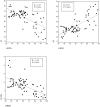The relationship between heart rate recovery and heart rate variability in coronary artery disease
- PMID: 16630090
- PMCID: PMC7313315
- DOI: 10.1111/j.1542-474X.2006.00097.x
The relationship between heart rate recovery and heart rate variability in coronary artery disease
Abstract
Background: Reduced heart rate recovery (HRR) in coronary artery disease (CAD) is predictive of increased cardiovascular mortality and is related to reduced parasympathetic tonus.
Objective: To investigate HRR and heart rate variability (HRV) measured at steady state condition and the relationship between these two parameters in CAD.
Materials and methods: In our study, we enrolled 33 (28 males, mean age 52.4 +/- 9.6 years) patients with CAD who did not have heart failure, atrial fibrillation, pacemaker, and any disease state that could affect the autonomic functions and 38 age-matched healthy subjects (21 males, mean age 48.3 +/- 7.8 years). All the patients underwent submaximal treadmill exercise testing (Bruce protocol). HRR was calculated by subtracting the heart rate values at the 1st, 2nd, and 3rd minutes of the recovery phase from the peak heart rate (HRR(1), HRR(2), HRR(3)). Before exercise testing, short-term steady state HRV analyses of all subjects were obtained with the time- and frequency-domain methods and were correlated to HRR. For frequency-domain analysis, low-frequency HRV (LF, 0.004-0.15 Hz), high-frequency HRV (HF, 0.15-0.5 Hz), and LF/HF ratio were measured for 5 minutes in the morning. For time-domain analysis, standard deviation of the normal-to-normal NN intervals (SDNN), square root of the mean squared differences of successive N-N intervals (RMSSD), and proportion derived by dividing the number of interval differences of successive N-N intervals greater than 50 ms by the total number of N-N intervals (pNN50) were obtained. Only HRR(3) was used for the correlation analysis.
Results: In CAD groups, the HF, an indicator of parasympathetic activation, was significantly reduced, whereas the LF and LF/HF values, which are indicators of sympathetic activity, were increased (P = 0.0001 for each parameter). The time-domain parameters SDNN, RMSSD, and pNN50 were significantly reduced in the patient group (P = 0.0001, P = 0.009, and P = 0.0001, respectively). Similar to the HRV parameters, the HRR(1), HRR(2), and HRR(3) values were significantly reduced in the patient group (P = 0.0001 for each parameter). We observed a significant negative correlation between HRR(3) and LF (r =-0.67, P = 0.0001) and between HRR(3) and LF/HF (r =-0.62, P < 0.0001), while there was a significant positive correlation between HRR(3) and HF, SDNN, RMSSD, and pNN50 (r = 0.69, P = 0.0001; r = 0.41, P = 0.0001; r = 0.31, P = 0.008; and r = 0.44, P = 0.0001).
Conclusions: HRR and HRV are significantly reduced in CAD. The reduction in HRR is parallel to the changes in HRV parameters. HRR, which can be measured easily in the recovery phase of exercise testing, can be used to detect the depression of parasympathetic tonus and to evaluate the basal autonomic balance in this patient group.
Figures
References
-
- Kleiger RE, Miller JP, Bigger JT, et al Decreased heart rate variability and its association with increased mortality after acute myocardial infarction. Am J Cardiol 1987;59: 256 – 261. - PubMed
-
- Ewing DJ, Campbell IW, Clarke BF. The natural history of diabetic autonomic neuropathy. Q J Med 1980;193: 95 – 108. - PubMed
-
- Malliani A, Lombardi F, Pagani F, et al Power spectral analysis of cardiovascular variability in patients at risk for sudden cardiac death. J Cardiovasc Electrophysiol 1994;5: 274 – 286. - PubMed
-
- Malpas SC, Gordon LP. Circadian variation of heart rate variability. Cardiovasc Res 1990;24: 210 – 213. - PubMed
-
- Stein PK, Bosner MS, Kleiger RF, et al Heart rate variability: A measure of cardiac autonomic tone. Am Heart J 1994;127: 420 – 424. - PubMed
MeSH terms
LinkOut - more resources
Full Text Sources
Medical
Research Materials
Miscellaneous



